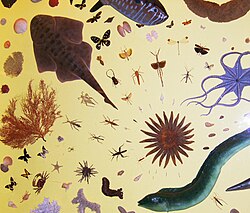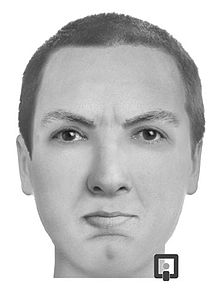Symmetry in biology

Symmetry in biology refers to the symmetry observed in
Biological symmetry can be thought of as a balanced distribution of duplicate body parts or shapes within the body of an organism. Importantly, unlike in mathematics, symmetry in biology is always approximate. For example, plant leaves – while considered symmetrical – rarely match up exactly when folded in half. Symmetry is one class of
While
The importance of symmetry is illustrated by the fact that groups of animals have traditionally been defined by this feature in taxonomic groupings. The Radiata, animals with radial symmetry, formed one of the four branches of Georges Cuvier's classification of the animal kingdom.[2][3][4] Meanwhile, Bilateria is a taxonomic grouping still used today to represent organisms with embryonic bilateral symmetry.
Radial symmetry
Organisms with radial symmetry show a repeating pattern around a central axis such that they can be separated into several identical pieces when cut through the central point, much like pieces of a pie. Typically, this involves repeating a body part 4, 5, 6 or 8 times around the axis – referred to as tetramerism, pentamerism, hexamerism and octamerism, respectively. Such organisms exhibit no left or right sides but do have a top and a bottom surface, or a front and a back.
George Cuvier classified animals with radial symmetry in the taxon Radiata (Zoophytes),
Many flowers are also radially symmetric, or "

Subtypes of radial symmetry
Three-fold triradial symmetry was present in Trilobozoa from the Late Ediacaran period.
Four-fold tetramerism appears in some jellyfish, such as

Hexamerism is found in the
Octamerism is found in corals of the subclass Octocorallia. These have polyps with eight tentacles and octameric radial symmetry. The octopus, however, has bilateral symmetry, despite its eight arms.
Icosahedral symmetry

Icosahedral symmetry occurs in an organism which contains 60 subunits generated by 20 faces, each an
In the early 20th century, Ernst Haeckel described (Haeckel, 1904) a number of species of Radiolaria, some of whose skeletons are shaped like various regular polyhedra. Examples include Circoporus octahedrus, Circogonia icosahedra, Lithocubus geometricus and Circorrhegma dodecahedra. The shapes of these creatures should be obvious from their names. Tetrahedral symmetry is not present in Callimitra agnesae.
Spherical symmetry
Spherical symmetry is characterised by the ability to draw an endless, or great but finite, number of symmetry axes through the body. This means that spherical symmetry occurs in an organism if it is able to be cut into two identical halves through any cut that runs through the organism's center. True spherical symmetry is not found in animal body plans.[1] Organisms which show approximate spherical symmetry include the freshwater green alga Volvox.[7]
Bacteria are often referred to as having a 'spherical' shape. Bacteria are categorized based on their shapes into three classes: cocci (spherical-shaped), bacillus (rod-shaped) and spirochetes (spiral-shaped) cells. In reality, this is a severe over-simplification as bacterial cells can be curved, bent, flattened, oblong spheroids and many more shapes.[13] Due to the huge number of bacteria considered to be cocci (coccus if a single cell), it is unlikely that all of these show true spherical symmetry. It is important to distinguish between the generalized use of the word 'spherical' to describe organisms at ease, and the true meaning of spherical symmetry. The same situation is seen in the description of viruses – 'spherical' viruses do not necessarily show spherical symmetry, being usually icosahedral.
Bilateral symmetry
Organisms with bilateral symmetry contain a single plane of symmetry, the sagittal plane, which divides the organism into two roughly mirror image left and right halves – approximate reflectional symmetry.
Animals with bilateral symmetry are classified into a large group called the bilateria, which contains 99% of all animals (comprising over 32 phyla and 1 million described species). All bilaterians have some asymmetrical features; for example, the human heart and liver are positioned asymmetrically despite the body having external bilateral symmetry.[14]
The bilateral symmetry of bilaterians is a complex trait which develops due to the
The AP axis is essential in defining the polarity of bilateria and allowing the development of a front and back to give the organism direction. The front end encounters the environment before the rest of the body so sensory organs such as eyes tend to be clustered there. This is also the site where a mouth develops since it is the first part of the body to encounter food. Therefore, a distinct head, with sense organs connected to a central nervous system, tends to develop.[17] This pattern of development (with a distinct head and tail) is called cephalization. It is also argued that the development of an AP axis is important in locomotion – bilateral symmetry gives the body an intrinsic direction and allows streamlining to reduce drag.
In addition to animals, the flowers of some plants also show bilateral symmetry. Such plants are referred to as
Biradial symmetry
Biradial symmetry is found in organisms which show morphological features (internal or external) of both bilateral and radial symmetry. Unlike radially symmetrical organisms which can be divided equally along many planes, biradial organisms can only be cut equally along two planes. This could represent an intermediate stage in the evolution of bilateral symmetry from a radially symmetric ancestor.[20]
The animal group with the most obvious biradial symmetry is the
Evolution of symmetry
Like all the traits of organisms, symmetry (or indeed asymmetry) evolves due to an advantage to the organism – a process of natural selection. This involves changes in the frequency of symmetry-related genes throughout time.
Evolution of symmetry in plants
Early flowering plants had radially symmetric flowers but since then many plants have evolved bilaterally symmetrical flowers. The evolution of bilateral symmetry is due to the
Evolution of symmetry in animals

Symmetry is often selected for in the evolution of animals. This is unsurprising since asymmetry is often an indication of unfitness – either defects during development or injuries throughout a lifetime. This is most apparent during mating during which females of some species select males with highly symmetrical features. For example, facial symmetry influences human judgements of human attractiveness.[26] Additionally, female barn swallows, a species where adults have long tail streamers, prefer to mate with males that have the most symmetrical tails.[27]
While symmetry is known to be under selection, the evolutionary history of different types of symmetry in animals is an area of extensive debate. Traditionally it has been suggested that bilateral animals evolved from a radial
Interpretations based only on morphology are not sufficient to explain the evolution of symmetry. Two different explanations are proposed for the different symmetries in cnidarians and bilateria. The first suggestion is that an ancestral animal had no symmetry (was asymmetric) before cnidarians and bilaterians separated into different evolutionary lineages. Radial symmetry could have then evolved in cnidarians and bilateral symmetry in bilaterians. Alternatively, the second suggestion is that an ancestor of cnidarians and bilaterians had bilateral symmetry before the cnidarians evolved and became different by having radial symmetry. Both potential explanations are being explored and evidence continues to fuel the debate.
Asymmetry
Although asymmetry is typically associated with being unfit, some species have evolved to be asymmetrical as an important adaptation. Many members of the phylum Porifera (sponges) have no symmetry, though some are radially symmetric.[29]
| Group/Species | Asymmetrical Feature | Adaptive Benefit |
|---|---|---|
| Some owls[30]
|
Size and positioning of ears | Allows the owl to more precisely determine the location of prey
|
| Flatfish[31] | Both eyes on the same side of their head | Rest and swim on one side (to blend in with sand floor of the ocean) |
| The scale-eating cichlid Perissodus microlepis[32] | Mouth and jaw asymmetry | More effective at removing scales from their prey |
| Humans[33][34][35] | Handedness and internal asymmetry of organs e.g. left lung is smaller than the right | Handedness is an adaptation reflecting the asymmetries of the human brain. |
| All vertebrates
|
Internal asymmetry of bowels
|
Internal asymmetry is thought to be caused by a developmental axial twist.[36]
|
-
Head of a male crossbill showing asymmetrical upper and lower beak
-
A winter flounder, a type of flatfish, with both eyes on the same side of its head
-
Hermit crabs have different sized claws
-
ARoman snailand its helical shell
-
gastropodsin the form of a helical shell
-
A red slug, clearly showing the pneumostome
-
Alife restoration of Stegosaurus stenopswith its asymmetrical plates.
Symmetry breaking
The presence of these asymmetrical features requires a process of symmetry breaking during development, both in plants and animals. Symmetry breaking occurs at several different levels in order to generate the anatomical asymmetry which we observe. These levels include asymmetric gene expression, protein expression, and activity of cells.
For example, left-right asymmetry in mammals has been investigated extensively in the embryos of mice. Such studies have led to support for the nodal flow hypothesis. In a region of the embryo referred to as the node there are small hair-like structures (monocilia) that all rotate together in a particular direction. This creates a unidirectional flow of signalling molecules causing these signals to accumulate on one side of the embryo and not the other. This results in the activation of different developmental pathways on each side, and subsequent asymmetry.[38][39]

Much of the investigation of the genetic basis of symmetry breaking has been done on chick embryos. In chick embryos the left side expresses genes called A more complete pathway is shown in the image at the side of the page.
For more information about symmetry breaking in animals please refer to the
Plants also show asymmetry. For example the direction of helical growth in Arabidopsis, the most commonly studied model plant, shows left-handedness. Interestingly, the genes involved in this asymmetry are similar (closely related) to those in animal asymmetry – both LEFTY1 and LEFTY2 play a role. In the same way as animals, symmetry breaking in plants can occur at a molecular (genes/proteins), subcellular, cellular, tissue and organ level.[42]
Fluctuating asymmetry

Fluctuating asymmetry (FA), is a form of biological asymmetry, along with anti-symmetry and direction asymmetry. Fluctuating asymmetry refers to small, random deviations away from perfect bilateral symmetry.[43][44] This deviation from perfection is thought to reflect the genetic and environmental pressures experienced throughout development, with greater pressures resulting in higher levels of asymmetry.[43] Examples of FA in the human body include unequal sizes (asymmetry) of bilateral features in the face and body, such as left and right eyes, ears, wrists, breasts, testicles, and thighs.
Research has exposed multiple factors that are associated with FA. As measuring FA can indicate developmental stability, it can also suggest the genetic fitness of an individual. This can further have an effect on mate attraction and sexual selection, as less asymmetry reflects greater developmental stability and subsequent fitness.[45] Human physical health is also associated with FA. For example, young men with greater FA report more medical conditions than those with lower levels of FA.[46] Multiple other factors can be linked to FA, such as intelligence[45] and personality traits.[47]See also
Biological structures
- Standard anatomical position
- Anatomical terms of motion
- Anatomical terms of muscle
- Anatomical terms of bone
- Anatomical terms of neuroanatomy
- Glossary of botanical terms
- Glossary of plant morphology
- Glossary of leaf morphology
- Glossary of entomology terms
- Plant morphology
Terms of orientation
- Handedness
- Laterality
- Proper right and proper left
- Reflection symmetry
- Sinistral and dextral
- Direction (disambiguation)
- Symmetry (disambiguation)
References
Citations
- ^ PMID 26640644.
- ^ McBirney, Alexander (2009). Georges Cuvier. In: The Philosophy of Zoology Before Darwin. Springer, Dordrecht. pp. 87–98.
- ^ Waggoner, Ben M. "Georges Cuvier (1769–1832)". UCMP Berkeley. Retrieved 8 March 2018.
Cuvier's insistence on the functional integration of organisms led him to classify animals into four "branches," or embranchements: Vertebrata, Articulata (arthropods and segmented worms), Mollusca (which at the time meant all other soft, bilaterally symmetrical invertebrates), and Radiata (cnidarians and echinoderms).
- ^ a b Cuvier, Georges; Griffith, Edward; Pidgeon, Edward (1834). The Mollusca and Radiata: Arranged by the Baron Cuvier, with Supplementary Additions to Each Order. Whittaker and Company. pp. 435–.
- ^ Waggoner, Ben M. "Georges Cuvier (1769–1832)". UCMP Berkeley. Retrieved 8 March 2018.
Cuvier's insistence on the functional integration of organisms led him to classify animals into four "branches," or embranchements: Vertebrata, Articulata (arthropods and segmented worms), Mollusca (which at the time meant all other soft, bilaterally symmetrical invertebrates), and Radiata (cnidarians and echinoderms).
- ISBN 978-0-08-010079-1.
- ^ a b Chandra, Girish (11 October 2008). "Symmetry". IAS. Retrieved 14 June 2014.
- PMID 14756328. 14756328 16341006.
- PMID 11163173.
- ^ Stewart, 2001. pp 64–65.
- ISBN 978-0-470-01590-2.
- PMID 14448959.
- PMID 16959965.
- ^ Valentine, James W. "Bilateria". AccessScience. Archived from the original on 18 January 2008. Retrieved 29 May 2013.
- ^ Finnerty, John R (2003). "Evolution & Development". IJDB. 47: 465–705.
- S2CID 83841216.
- PMID 16237677.
- ^ "SCROPHULARIACEAE – Figwort or Snapdragon Family". Texas A&M University Bioinformatics Working Group. Retrieved 14 June 2014.
- The Columbia Electronic Encyclopedia(2007).
- .
- S2CID 4467701.
- S2CID 205033495.
- .
- PMID 19895716.
- S2CID 245330736.
- ^ Grammer, K.; Thornhill, R. (1994). Human (Homo sapiens) facial attractiveness and sexual selection: the role of symmetry and averageness. Journal of comparative psychology (Washington, D.C. : 1983), 108(3), 233–42.
- ^ Maynard Smith, John; Harper, David (2003). Animal Signals. Oxford University Press. pp. 63–65.
- .
- ^ Myers, Phil (2001). "Porifera Sponges". University of Michigan (Animal Diversity Web). Retrieved 14 June 2014.
- .
- S2CID 4311712.
- PMID 22970282.)
{{cite journal}}: CS1 maint: multiple names: authors list (link - ISBN 978-0-08-043076-8.
- ISBN 978-1-938168-13-0. Retrieved 11 August 2014.
- ^ Holder, M. K. (1997). "Why are more people right-handed?". Scientific American. Retrieved 14 April 2008.
- S2CID 7399128.
- ISSN 0008-4301.
- S2CID 18007532.
- S2CID 4373455.
- S2CID 15417027.
- PMID 19359542.
- PMID 24474806.
- ^ JSTOR 2406192.
- ^ Tomkins, J. L.; Kotiaho, J. S. (2001). Fluctuating Asymmetry. London: Macmillan Publishers Ltd. pp. 1–5.
- ^ ISBN 978-0195340983.)
{{cite book}}: CS1 maint: multiple names: authors list (link - .
- .
Sources
- Ball, Philip (2009). Shapes. Oxford University Press.
- Stewart, Ian (2007). What Shape is a Snowflake? Magical Numbers in Nature. Weidenfeld and Nicolson.
- Thompson, D'Arcy (1942). On Growth and Form. Cambridge University Press.
- ISBN 3-7913-1990-6.









